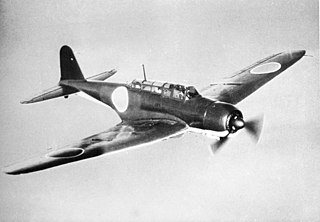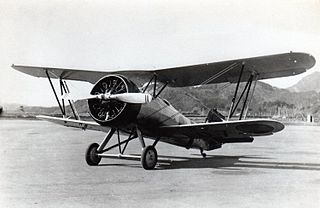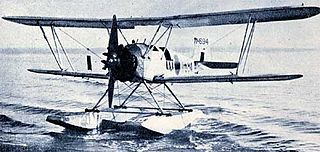
The Aichi B7A Ryusei was a large and powerful carrier-borne torpedo-dive bomber produced by Aichi Kokuki for the Imperial Japanese Navy Air Service during the Second World War. Built in only small numbers and deprived of the aircraft carriers it was intended to operate from, the type had little chance to distinguish itself in combat before the war ended in August 1945.

The Mitsubishi A5M, formal Japanese Navy designation Mitsubishi Navy Type 96 Carrier-based Fighter (九六式艦上戦闘機), experimental Navy designation Mitsubishi Navy Experimental 9-Shi Carrier Fighter, company designation Mitsubishi Ka-14, was a WWII-era Japanese carrier-based fighter aircraft. The Type number is from the last two digits of the Japanese imperial year 2596 (1936) when it entered service with the Imperial Navy.

The Nakajima B5N was the standard carrier-based torpedo bomber of the Imperial Japanese Navy (IJN) for much of World War II. It also served as a high level bomber.

The Nakajima A4N was a carrier-based fighter used by the Imperial Japanese Navy, and the last biplane designed by Nakajima. The first prototype was completed in 1934, but, due to engine trouble, the aircraft did not see service until 1936. Given the Nakajima internal designation Nakajima YM, but the Japanese Navy designation was Navy Type 95 Carrier Fighter. A total of 221 were built. It saw combat in the Second Sino-Japanese War in the late 1930s.

The Yokosuka B4Y was a carrier-borne torpedo bomber used by the Imperial Japanese Navy Air Service from 1936 to 1943. The B4Y replaced the Mitsubishi B2M2 and the Yokosuka B3Y, and was the last biplane bomber used operationally by the Imperial Japanese Navy. The Allied reporting name was "Jean". This aircraft was mistakenly identified by the British as the Nakajima Navy G-96.

The Nakajima G5N Shinzan was a four-engined, long-range heavy bomber designed and built for the Imperial Japanese Navy prior to World War II. The Navy designation was "Experimental 13-Shi Attack Bomber"; the Allied code name was "Liz".

The Kugisho B3Y, or Navy Type 92 Carrier Attack Bomber, also popularly titled Yokosuka B3Y, was a Japanese carrier-based torpedo bomber of the 1930s. It was designed by the Naval Air Technical Arsenal at Yokosuka, and while unimpressive during testing, it was ordered into service by the Imperial Japanese Navy and used until replaced by more capable aircraft.

The Mitsubishi Army Type 92 Reconnaissance Aircraft (九二式偵察機) was a Japanese short-range reconnaissance aircraft of the 1930s designed by Mitsubishi for the Imperial Japanese Army Air Force. A total of 230 were built, serving between 1933 and 1936. A parasol monoplane, the Type 92 was the first military aircraft powered by an engine both designed and manufactured in Japan to enter service.
The Nakajima C3N-1 was a prototype Japanese carrier-based reconnaissance aircraft of the 1930s. It was a single-engine monoplane with a fixed undercarriage. Although only two examples were built, they were both used operationally, carrying out land-based reconnaissance missions during the Second Sino-Japanese War.
The Nakajima B3N was a prototype Japanese carrier-based torpedo-bomber aircraft of the 1930s. A single-engined biplane with a crew of three, it was unsuccessful, only two being built.

The Yokosuka Ro-go Ko-gata was a Japanese reconnaissance floatplane developed during the First World War by the Japanese Navy Arsenal at Yokosuka, and one of the first indigenous Japanese aircraft to enter production. There were 218 of these aircraft built for the Imperial Japanese Navy, which remained in use until 1928.

The Yokosuka K4Y was a Japanese floatplane trainer of the 1930s. A single engined two-seat biplane, 211 K4Ys were built between 1933 and 1940, serving as the Imperial Japanese Navy's basic floatplane trainer throughout the Second World War.
The Aichi F1A was a prototype Japanese floatplane of the 1930s. A single-engined biplane, the F1A was intended as a short-range observation aircraft suitable for operation off the Imperial Japanese navy's warships, but only two were built, the Mitsubishi F1M being selected instead.

The Mitsubishi 3MT5 was a Japanese bomber of the 1930s. It was a twin-engined biplane that was intended to operate from Japanese aircraft carriers, but proved to be unsuitable for carrier use, and the eleven aircraft built were instead used as land-based trainers.

The Mitsubishi G1M was a long-range twin-engined attack bomber built by Mitsubishi for the Imperial Japanese Navy in the 1930s.

The Mitsubishi 1MF10 or Mitsubishi experimental 7-Shi carrier fighter (七試艦上戦闘機) was a prototype Japanese monoplane single-seat carrier-based fighter aircraft of the 1930s. Two were built for the Imperial Japanese Navy, but both were lost in crashes, with no production following.
The Mitsubishi Ka-8 or Mitsubishi Experimental 8-Shi Two-seat Fighter was a prototype Japanese two-seat carrier-based fighter aircraft of the 1930s. Two were built, but no production followed.
The Nakajima D3N was a Japanese carrier-based dive bomber of the 1930s. Three prototypes were built for the Imperial Japanese Navy, but no production followed, with the Aichi D3A being selected instead.
The Kawanishi K8K was a Japanese floatplane trainer designed and built by the Kawanishi Aircraft Company for the Imperial Japanese Navy. It was selected for production, but only a small number were built before a change in the Japanese Navy's training needs led to production being stopped.
The Watanabe K8W was a Japanese floatplane trainer designed and built by Watanabe for the Imperial Japanese Navy.













